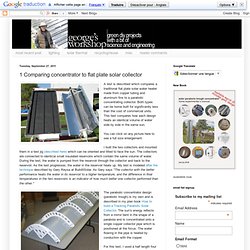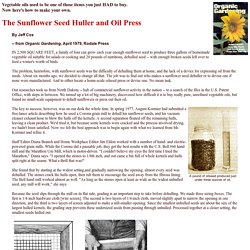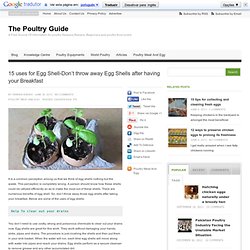

Silent rooftop wind turbines could generate half of a household's energy needs. Small wind turbines scaled to the right size for residential and urban areas have so far lived in the shadows of their larger wind-farm-sized counterparts.

The power output has been too low for a reasonable return on investment through energy savings and the noise they produce is louder than most homeowners can deal with. A Dutch renewable energy start-up called The Archimedes is working to solve both of those problems in a new class of small-scale wind turbine -- one that is almost silent and is far more efficient at converting wind into energy. The company states that the Liam F1 turbine could generate 1,500 kWh of energy per year at wind speeds of 5m/s, enough to cover half of an average household's energy use.
When used in combination with rooftop solar panels, a house could run off grid. "When there is wind you use the energy produced by the wind turbine; when the sun is shining you use the solar cells to produce the energy," The Archimedes CEO Richard Ruijtenbeek said. Wallet made from a computer keyboard.
Knobby All Terrain Rubber Wallet with Optional Smack-lights. One of my neighbors put a pile of mtb tires out on the street for garbage pick up.

Naturally, my hunter-gatherer instincts took over and I dragged them all back to my lair to gloat over. It's possible that I have too many old bikes (nevah!). May as well have too many tires as well. Especially nice ones. And I truly dig the tread patterns and want to make everything out of them. Yeah, so anyway...MTB Tires are cool. What These 6 Friends Did To This Bus Is Brilliant. They Will Be Talking About This For A Long Time. Talk about the experience of a lifetime!

6 friends from Australia banded together on what would prove to be an epic journey. Portable Power Station - Urban Survival. 1 Comparing concentrator to flat plate solar collector. A test is described which compares a traditional flat plate solar water heater made from copper tubing and aluminum fins to a parabolic concentrating collector.

Both types can be home built for significantly less than the cost of commercial units. This test compares how each design heats an identical volume of water side by side in the same sun. You can click on any picture here to see a full size enlargement. I built the two collectors and mounted them in a test jig (described here) which can be oriented and tilted to face the sun.
The collectors are connected to identical small insulated reservoirs which contain the same volume of water. The parabolic concentrator design (parabolic trough) is my own and is described in my plan book How to build a Tracking Parabolic Solar Collector. For this test, I used a half length four foot long reflector. The flat plate collector consists of a network of copper pipe and aluminum absorber plates which are thermally coupled to the copper. GeoPathfinder. Energy Efficient Food Preservation Once you've gotten started with gardening, you'll soon have to find a way to deal with the surplus (hopefully you've planned for this!).

Not everything can be eaten fresh. Some foods may need to be stored for later consumption. Reducing the amount of energy you use for food storage will further shrink the carbon footprint that you have already reduced by eating locally, growing your food biologically, and replacing your fossil-fueled tools with something more task-appropriate (like a garden fork). Oil Press. By Jeff Cox -- from Organic Gardening, April 1979, Rodale Press IN 2,500 SQUARE FEET, a family of four can grow each year enough sunflower seed to produce three gallons of homemade vegetable oil suitable for salads or cooking and 20 pounds of nutritious, dehulled seed -- with enough broken seeds left over to feed a winter's worth of birds.The problem, heretofore, with sunflower seeds was the difficulty of dehulling them at home, and the lack of a device for expressing oil from the seeds.

About six months ago, we decided to change all that. The job was to find out who makes a sunflower seed dehuller or to devise one if none were manufactured. And to either locate a home-scale oilseed press or devise one. No mean task.Our researches took us from North Dakota -- hub of commercial sunflower activity in the nation -- to a search of the files in the U.S.
Patent Office, with stops in between. Tools Required 1. At Least 10 Uses for Wood Ash. 1 - Dust Baths - place cold ashes where your birds can get to them, the dust baths will control bugs 2 - Ring Around the Rosie - spread a low ring around individual plants are gardens to deter slugs/snails 3 - Mix into your Compost - in the north, this is the perfect thing!

4 - Lawn Fertilizer - Wood ash contains 10-25% calcium, 1-4% magnesium, 5-15% potassium and 1-3% phosphorus. 5 - Cleaning Agent - mix with water to form a paste and use on the glass in your wood stove or fireplace. Ditto for rings left on wood furniture from glasses. 15 uses for Egg Shell-don't through away Egg Shells after having your Breakfast. It is a common perception among us that we think of egg shells nothing but the waste.

This perception is completely wrong. Ancient Passive Cooling. By Josh Moran You’ve probably seen various “family trees” in museums that try to illustrate the evolution of human beings.

They start out with an ape-like creature with a scientific-sounding name at the bottom and then branch outwards and upwards, culminating with something like Ozzie and Harriet perched at the top. Imagine that same kind of tree but one that shows the evolution of the manner in which we have cooled and heated our living spaces since the dawn of human history. It would start out with various ancient passive systems, evolve into controlled fires, work its way up to simple fans, branch out to evaporative coolers and finally make its way to modern HVAC systems. However, unlike the family trees where the branches of human ancestors come to an abrupt end, in the heating and cooling tree, ancient passive systems don’t entirely disappear. How to Make Charcoal Soap.